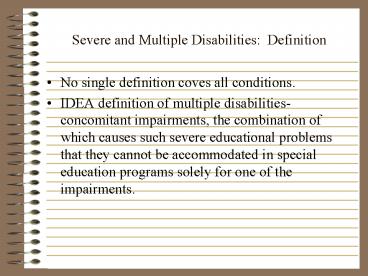Severe and Multiple Disabilities: Definition - PowerPoint PPT Presentation
1 / 17
Title:
Severe and Multiple Disabilities: Definition
Description:
IDEA definition of multiple disabilities- concomitant impairments, the ... No single definition coves all conditions. ... No single definition covers all conditions. ... – PowerPoint PPT presentation
Number of Views:209
Avg rating:3.0/5.0
Title: Severe and Multiple Disabilities: Definition
1
Severe and Multiple Disabilities Definition
- No single definition coves all conditions.
- IDEA definition of multiple disabilities-
concomitant impairments, the combination of which
causes such severe educational problems that they
cannot be accommodated in special education
programs solely for one of the impairments.
2
Multiple Disabilities Definition
- No single definition coves all conditions.
- IDEA definition of multiple disabilities-
concomitant impairments, the combination of which
causes such severe educational problems that they
cannot be accommodated in special education
programs solely for one of the impairments.
3
Severe Disabilities Definition
- No single definition covers all conditions.
- IDEA definition of severe disabilities- The term
refers to children with disabilities who, because
of the intensity of their physical, mental, or
emotional problems, need highly specialized
education, social, psychological, and medical
services in order to maximize their full
potential.
4
Severe and Multiple Disabilities Characteristics
- Six Categories
- Intellectual functioning- most have severe
impairments - Adaptive skills- especially self-care and social
skills - Motor development- significant delays in fine
and gross motor skills - Sensory impairments- hearing and visual
impairments are common
5
- Health care needs- medical procedures, medical
aids, medications - Communication skills- challenges requiring
augmentative and alternative communication
6
Causes and Prevalence
- Causes
- 30-40 percent have no identifiable cause
- Prenatal biomedical factors
- Disorder of brain formation
- Genetic Metabolic Disorders The most common
associated with multiple disabilities interferes
with necessary enzyme production
(phenylketonuria). - Prevention
- Prenatal diagnosisamniocentesis, chorionic,
etc - Maternal education
7
- Prevalence
- Multiple disabilities- 0.18 percent of all
students ages 6 to 21 who are served in IDEA
programs - Severe disabilities- No data provided on the
prevalence because IDEA does not identify severe
disabilities as a separate category.
8
Recessive Gene Transmission
9
Dominant Gene Transmission
10
Evaluation Process
- Determining the Presence of a Disability
- Detected at birth
- Screening process by a physician (Apgar Test-
Evans, 1997) - Nature and Extent of a Special Education and
Related Services - Ecological Assessment- examines environments,
then identifies activities and skills needed
(task analysis) - Making Action Plans (MAPs)- Customizing
students educational program (visions,
strengths, needs)
11
Ecological Assessment
- Five Phases
- Identify the curriculum domains
- Identify and survey current and future natural
environments - Divide the relevant environments into
sub-environments - Inventory the sub environments for the relevant
activities performed there - Determine the skills required for performance of
the activities
12
MAPS
- The facilitator uses the following eight
questions to help brainstorm of ideas - What is MAPS?- they explain the purpose
- What is your history?- family and student share
background information - What are your dreams?- expectations
- What are your nightmares?- fears
- Who are you?- use as many adjectives as possible
- What are your strengths, gifts, and talents?
- What do you need?- to meet expectations
- What is the plan of action?- includes specific
steps
13
Progress in the General Curriculum
- Research A synthesis of 19 research studies
found 5 themes related to successful inclusion - 1) Collaborating at all levels.
- 2) Teaching new skills in general education
classes. - 3) Promoting friendships in inclusive settings.
- 4) Facilitating positive outcomes for classmates
with disabilities. - 5) Adapting the students curriculum.
14
Progress in the General Curriculum
- Curricular Goals
- Increase priority skills related to ecological
assessment - Expand relationships with schoolmates and foster
school and community memberships
15
- Implement Instruction
- Instructional adaptations
- Multilevel curriculum and curriculum overlapping
- Universal design
- Three state-of-the-art strategies
- Partial participation and use of adaptations
- Cooperative learning
- Peer tutoring
16
Programs and Practice
- Early Childhood Years- Circle of Inclusion-
offers desirable social and communicative
environment. - Elementary Years- utilizes a collaborative
problem-solving process and a critical friend
to facilitate the action research process. - Middle and Secondary Years- Whittier H.S. removed
negative special education labels and all
students were grouped heterogeneously. - Transition and Postsecondary Years- students can
attend Asbury College and receive high school
credit.
17
- Foster Collaboration
- Professional- focus on cooperative learning,
multilevel learning, and peer support - Student and family- arrange for the student to
be read to and to play games with classmates






























